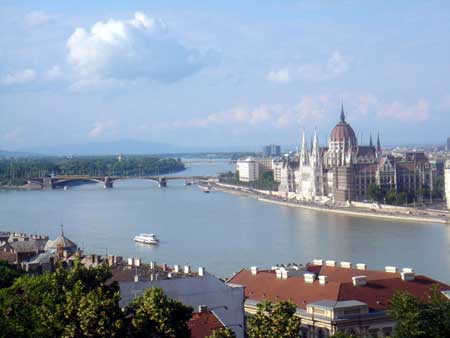Swiftly Down the Danube

We left Vienna in the bright sun of early morning on a hydrofoil, bound 300 miles down the Danube to Budapest, gateway to the East. Of the several boats moored quayside at the Shiffahrtzentrum, I was surprised to discover ours was not one of the several multidecked, glassy vessels bobbing in the river current, but rather the squat, sealed vessel that looked to me like a half-submerged bus or a big blue cigar. It was either Russian- or Bulgarian-built, judging by the Cyrillic on the steel bulkheads, but it would take us all the way to Budapest in quiet comfort.
The Danube was broad and vaguely industrial around Vienna, and grey and wind-tossed by the time we reached Bratislava. Twice we labored through locks that lowered us over a hundred feet vertically: massive steel and concrete things as silent as the grave.
We left Vienna in the bright sun of early morning on a hydrofoil, bound 300 miles down the Danube to Budapest, gateway to the East. Of the several boats moored quayside at the Shiffahrtzentrum, I was surprised to discover ours was not one of the several multidecked, glassy vessels bobbing in the river current, but rather the squat, sealed vessel that looked to me like a half-submerged bus or a big blue cigar. It was either Russian- or Bulgarian-built, judging by the Cyrillic on the steel bulkheads, but it would take us all the way to our destination in quiet comfort.
The Danube was broad and vaguely industrial around Vienna, and grey and wind-tossed by the time we reached Bratislava. Twice we labored through locks that lowered us over a hundred feet vertically: massive steel and concrete things as silent as the grave: one was a brief (and surprising; we'd just begun the voyage) and just at Vienna's city limits where the Danube canal rejoins the river. The other was a 30 meter drop in what I discovered later was an enormous estuary, almost an inland delta in a river system that later re-finds its shape and continues with better definition. It was the Vodnè dielo Gabcikovo, just miles from the triple border of Austria, Slovakia, and Hungary.
After hours of skirting the Slovak border east of Vienna we entered Hungary definitively, and around us the terrain grew hilly and forested, a lovely change of scenery from West Africa. Then, our trajectory changed fast from east, to south. We had rounded the bend at Vác and would soon be in Budapest. This was, for me, the most beautiful part of the trip, as the forest on both sides gave the river a primitive and wild look that obscured the millions that have been invested in ensuring its navigability. I read afterwards that the Danube, aka Donau (Austria), Duna (Hungary) and dozens of other names, is one of Europe's principal riverine transport corridors, and the nations that use it have invested millions in dredging, channeling, and stabilizing the watercourse to ensure goods and people can flow up and down it as necessary. Over the course of the afternoon we shared the waters with dozens of ferries, transporters, booze cruises, barges, tugs, and even small container haulers.
But at no point under the cloudy afternoon sky was it blue, blue, blue, flowing instead through greens, grays, and silvers as we descended to Budapest. We arrived at mid-afternoon, under a glowering sky. We would spend a week in Budapest before returning home, and would discover then that the Danube is a central feature to the region, as much a part of the landscape as a part of the culture. Somehow, to experience at water level on board a ship just as much a part of the region's history, seemed surprisingly appropriate.
Trackbacks
The author does not allow comments to this entry

Comments
Display comments as Linear | Threaded